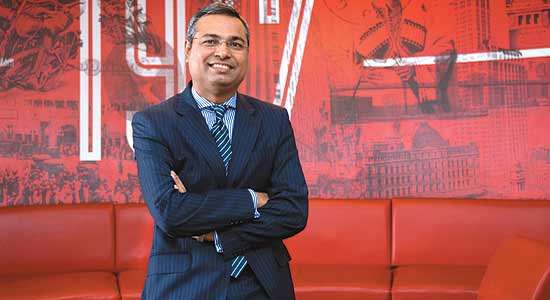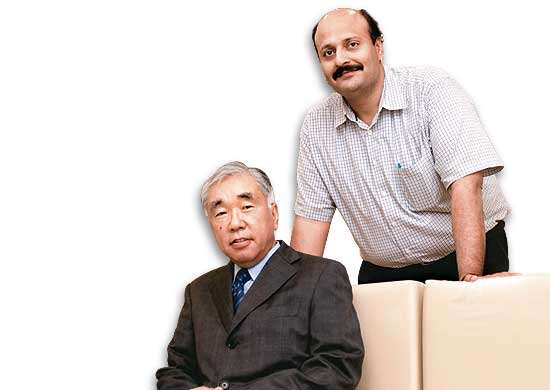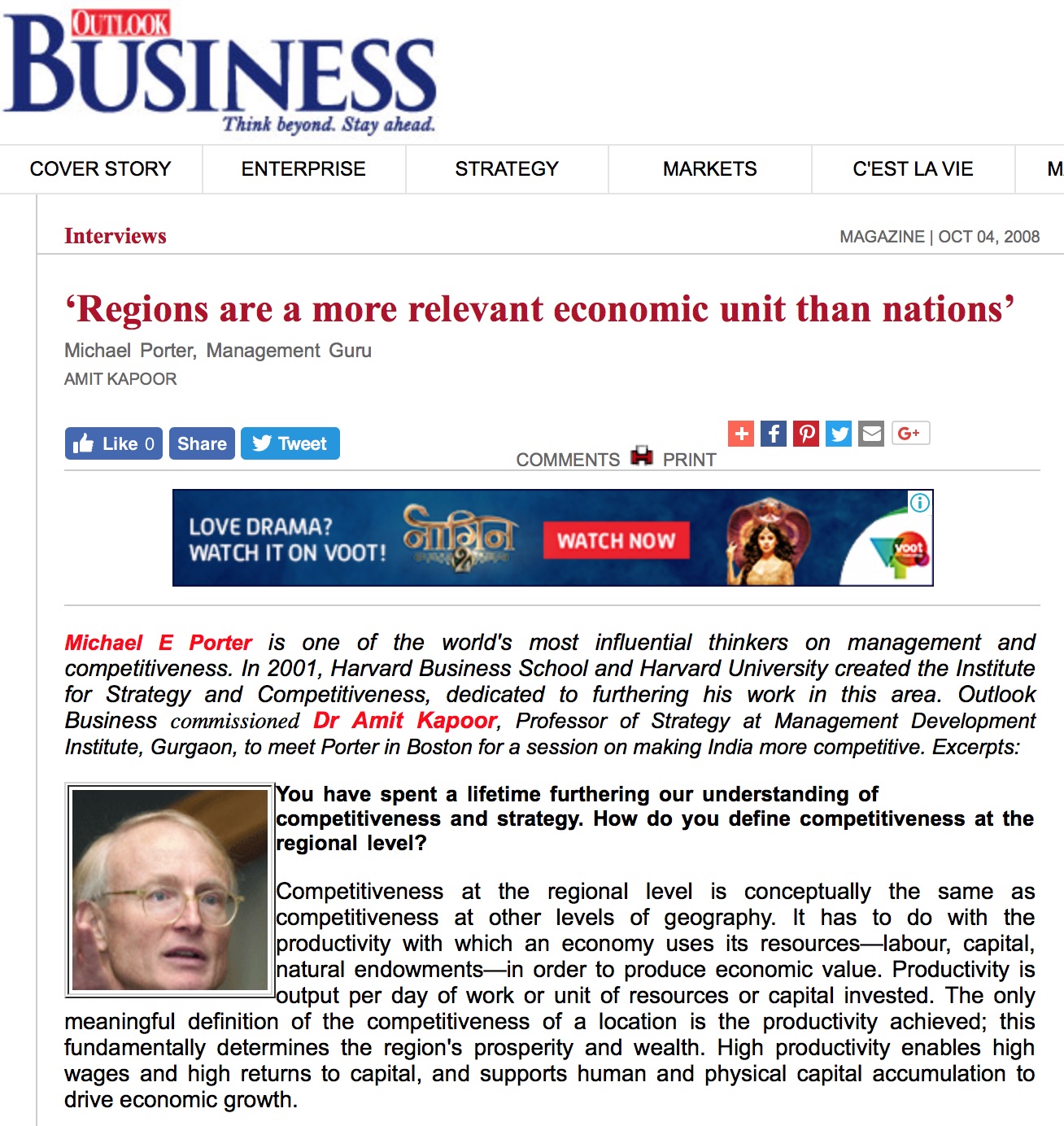Salil Parekh, CEO of Financial Services (Asia), Capgemini, shares his insights on the impact of disruptive technology on the company’s business with Dr Amit Kapoor, Honorary Chairman, Institute for Competitiveness.
Give us a rundown of your industry.
Worldwide, consulting and IT services is one sector that is yet to see some kind of consolidation. There are many companies operating in this space. Big companies like IBM and HP have a turnover in the range of $40-50 billion. Then we have players like Capgemini with a turnover of about $12 billion, followed by companies like CSU and Accenture. Next in the order are large Indian companies like TCS, Infosys and Wipro. In the global context, the sector is largest in the US region; probably half of the sector operates there (40%). It is very large in Europe, especially the UK, France, the Netherlands and Germany. In Asia, Japan has a robust services sector. The sector has grown significantly in China also. Even in India, it has become very important.
Within the sector, which are the segments that are growing robustly in Asia?
In the IT space the growth comes mainly from the use of technology to support businesses. Take the case of a retail company operating in Asia-Pacific, for instance. Growing demand is fuelling the growth of the retail sector. Retailers need IT systems to understand what their customers want and to set up customer relationship management systems. They need it to manage their supply chain and delivery mechanisms. They put in business analytics to understand what the customer is looking for. Then they need someone to manage that technology. That is when players like us come into the picture. Thus, the growth of the operating companies, coupled with the burgeoning client base in Asia, has generated a lot of business for companies like us.
How do you create differentiation?
We are the only non-American and non- Indian player in our sector that is operating with a global footprint. The American players have developed a very American model, while the Indian players are very India-centric. Capgemini has its roots in Europe and has worked with a number of European companies. We are present in the US as well. We have about 100,000 employees, out of which 32,000 are in India. So, our presence in India is also significant. I think what differentiates us is our collaborative way of working. There is client intimacy. We don’t have a fixed answer to impose upon our clients. People who work with us realise that we develop a solution for them by combining their ideas with our thinking. In addition, we are not as big as some of our competitors. So, we have decided to compete in specific domains or sub-sectors.
For us, attrition is in the mid-double digits. Some level of attrition is healthy as it rejuvenates teams.
To cite one case, we do eight or nine things in the financial sphere. We work on payment systems and credit cards. We also work in the insurance field, where we work on claims processing and policy administration. So, these are the things we do very well and we specialise in them. Similarly, we specialise in the utilities and the public sector as well. We are a leading player for tax programmes of various governments. We have bagged some large contracts from the UK government. If you look at utilities, we are very good at smart meter reading and recording. In the case of the retail sector, we are proficient at supply chain optimisation. If you talk about life sciences, then we are efficient on the regulatory side in the pharmaceutical division. So, we have taken some definite domains and tried to develop expertise in them.
Tell me more about how you provide support to the regulatory system in the pharma sector.
Take the case of US pharmaceutical companies. They have to comply with a host of regulatory requirements stipulated by the FDA. Our consulting business gives them guidance on the steps they need to take in developing new drugs or launching new products. We help them build a system that allows them to capture deviations early in the cycle and reduce
research costs.
Such support services have to effectively reduce the cost for the client. So, what are the cost implications?
Our consulting business is focused on giving you advices and insights. We work on programmes that help companies improve their growth rates, market share and geographical access. In terms of support or maintenance services in the IT and BPO space, we focus on 5-40% cost reductions. We have actually taken up business transformation projects, where we have said that we will double the operating margins. For a retail company, if you go from 2-4%, it is a massive improvement. So, those are the sort of benefits we provide to our clients.
How are customers changing?
Customers are becoming more demanding by the day. They are more aware of the capabilities of the service providers. The new generation of CFOs and CEOs are tech savvy. They use advanced technology in their day-to-day lives and demand that same experience when they work with their service providers. This is a big change we have started to observe. Customers’ understanding of the business is very sophisticated. Also, they are becoming hugely price-sensitive.
How are you telling people that you can outsource your core activities to us?
Let me give you examples. We work with many consumer-based industries in India that have outsourced the maintenance of their internal applications to us. We run that for them across all of India. As they grow in size, we scale up our support for them. I mentioned earlier that we work for the UK government.
The tax processing for every citizen in the UK is handled on systems that we manage. These are the kind of outsourcing arrangements in place globally and they have different benefits.
A business in the US or Europe, which does not have a fast growth trajectory, focuses more on maintaining or improving a service level and then reducing the cost. Businesses in India and China are not concerned about cost but we don’t want that to cause any performance degradation as they grow. So, different clients have different objectives.
Cloud computing is emerging as the next big thing. Tell me about its impact on your business.
We have a huge advisory business that guides firms on making decisions about the cloud. Businesses can build their own private cloud or lease private cloud from a provider or seek the services of someone like us who can build it jointly with applications and services. So, if some business is looking for an enterprise to run its applications and services from our cloud, we can provide that on a transaction basis. The cloud technology will have a big impact on businesses. We help clients think through what they want to do and get it done for them on the cloud.
Your business is not going to get impacted in a negative way. But there could be a disruptive technology in the infrastructure space. What do you foresee happening there?
We have to ensure that we provide cloud-based infrastructure services simultaneously with the traditional services. The arrival of new technologies does not necessarily mean that you have to discard old ones. In future, I think we will have a multi-technology set-up. So, the present data centres will exist and yet some new as well as old companies will migrate to the cloud. We have to create an infrastructure business that integrates all this in the future. So, our approach in infrastructure is to improve our current efficiencies and also provide cloud services to those who are looking for it.
Are the small players going to prefer the cloud while the big players maintain their status quo?
It is difficult to say. The attraction of a cloud is that you don’t have any upfront investment. The small players might adopt it immediately. The big players are also going to get huge benefits from it eventually, but they may take some time to adopt it. So, players from both sides will look at it.
Who are your competitors in the consulting and infrastructure businesses?
In both the spaces, our competitors are the same companies. In the consulting business, we compete with some strategy firms also. Our main rivals are large American players and some of the Indian players that are starting to build their consulting business. In infrastructure, it is mainly HP and IBM. There is no one else because these companies have invested heavily in the infrastructure business.
In terms of maintenance services in the IT and BPO space, we focus on 5-40% cost reductions.
When you started this business in India, what was the reason for looking at this set-up? Was it cost or availability of labour or both?
When we first started in India several years ago, the idea was to build local consulting processes for Indian businesses. As we started doing business across sectors, we also realised that there was a massive opportunity in IT offshoring because of the cost advantage. So, with local consulting business we also started augmenting offshore businesses to take advantage of the competitive cost structures available.
Today, the main driver for our growth in India is the offshore business. And with 32% of our worldwide staff in India, we have a massive competitive advantage. We also have a large local consulting business. We serve 40 clients within India, with a thousand people working exclusively for the government sector and some MNCs.
What are the steps you take to maintain the productivity of employees and to keep the processes well-managed?
Our belief is, the greater the level of standardisation, the more credible the process is. It again comes back to the business mix. The key question is, are we going to do 200 different types of activities or just 20? To give an example, we work on maintaining SAP systems, which is a large chunk of our business. All our clients build and run on the same methodology, giving us a scale to make efficiency possible for that set of the process. In India there are 30-35 distinct areas in which we operate. We also have internal targets, ranging from 5-15% and also productivity improvement ambitions. These are achieved by using technology internally, like sharing best practices, building templates, using previously developed solutions for solving future problems, optimum and efficient utilisation of human resources and eliminating wasteful activities.
And how do you manage attrition?
Today, for us, attrition is in the mid-double digits. So, it is not high. In our business people spend a number of years in a department and then go on to do different things within the industry, be it consulting or IT services. So, some level of attrition is healthy as it rejuvenates teams.
As an enterprise, how do you assess and manage political risks?
We operate in 30-34 countries. But we are not in a lot of politically sensitive nations.
How do you decide on the business you are going to do?
Our first decision will be to focus only on a few areas. But how will you select those areas? We look at areas where the market is growing, evaluate the assets we have and then make sure that our assets match the demands of the growth areas. We have an internal process called portfolio rejuvenation, wherein we map our assets on an ongoing basis. We may discover that our competitive edge in certain areas has decreased or the growth probability and margin probability in certain areas in the market has decreased. So, we reduce the focus on them and try to pull out something that is more attractive in the market. It’s an ongoing process that we, as a management team, have to build within our business.
What are the new geographies on which you are going to focus?
Our focus is on India and China. We have bought a company in Brazil and the nation will be a growth area for us. In addition, we are looking at Poland, Romania and Turkey. Within Asia-Pacific, we have plans for Thailand, Singapore and Indonesia.
How would you define the term strategy?
Strategy is the testing of a set of ideas and beliefs put together and the analysis of these ideas, whether it is working or not. In our business, we develop a set of views and hypotheses.
We observe where the business is going after the adoption of these views in a set time frame. Broadly speaking, it is about having a point of view of how things will move in the future. It depends on different sectors. For power plants, there is a very long time horizon. On the other hand, consulting and IT services have the shortest time horizon as there is not enough capital at risk here. So, you have more than enough time to readjust and get it right. It is really a function of how much capital and the time horizon you put in together.
What do you think about leadership?
In my view, the success of any endeavour, whether it is business or any other enterprise, is a measure of the person responsible for it.
I lead one of the six strategic units in Capgemini. And the success or failure of any of these business units gauges the potential of the leader heading it. So, for me, the critical element of success is to find the person most suited for running that unit.
Young persons in this country are a major stakeholder. How do you keep them motivated as they can be fickle too?
They are not fickle but very demanding. The requirements of the average executive staff or consultant within a team in Capgemini in India have changed today. Ten years ago, there was a much greater orientation towards building long careers and dedication to the enterprise.
Today, there is dedication but more in the spirit of what one can learn. The focus is definitely on personal growth as well. We have a generation that is multi-tasking on a regular basis between the cell phone, Facebook, Twitter and television. They need constant feedback on their learning, progression and development. Beyond that, they also demand assurance that the work they are doing has some meaning.
Anything else you would like to share?
Perhaps some interesting points about Capgemini. One of the things that we have done is carving out this $4 billion portfolio that I run. The portfolio is to build a new type of IT or consulting services unit by combining the legacy of Capgemini with the best that is new in the world to get higher growth and higher margins in the industry.
It is a new concept that we have launched in a smaller way in the financial services business in the last two years. It has worked very successfully for us. That business grew by a good 24% last year. We have an ambition to grow this UK-US-Asia business at 15% in the next 24 months and have margins that are 15% or more in that business. So, it’s a new approach that we are trying to put in place
4 CS Model
Context
- Collaboration between the firms almost absent
- Maintenance of the productivity of extensive workforce
- Creation of cost advantage a constant battle
Company
- Dominant in specific spaces, adopting a policy of standardisation
- Working with the customers, belief in client intimacy
- Emerging as the preeminent global player through cost advantage
Competition
- Both big and small players, and some strategy firms
Customer
- Local and global
- Government and business firms
- Very demanding and intelligent
Evolution of the Industry
Wave 1
- Traditionally developed, local consulting processes.
Wave 2
- Outsourcing of core business activities to the industry.
Wave 3
- Emerging global presence but limited consolidation across the industry
CEOs across India speak on strategy and leadership, in an exclusive series developed jointly by Outlook Business and the Institute for Competitiveness. The Strat Speak interaction was published with Outlook Business on April 16, 2011.























